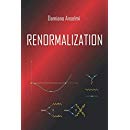Papers
Here are all papers published on Renormalization.COM
A more compact single-page list can be found at this link
A theory of quantum gravity has been recently proposed by means of a novel quantization prescription, which is able to turn the poles of the free propagators that are due to the higher derivatives into fakeons. The classical Lagrangian contains the cosmological term, the Hilbert term, $
\sqrt{-g}R_{\mu \nu }R^{\mu \nu }$ and $\sqrt{-g}R^{2}$. In this paper, we compute the one-loop renormalization of the theory and the absorptive part of the graviton self energy. The results illustrate the mechanism that makes renormalizability compatible with unitarity. The fakeons disentangle the real part of the self energy from the imaginary part. The former obeys a renormalizable power counting, while the latter obeys the nonrenormalizable power counting of the low energy expansion and is consistent with unitarity in the limit of vanishing cosmological constant. The value of the absorptive part is related to the central charge $c$ of the matter fields coupled to gravity.
J. High Energ. Phys. 05 (2018) 27 | DOI: 10.1007/JHEP05(2018)027
The “fakeon” is a fake degree of freedom, i.e. a degree of freedom that does not belong to the physical spectrum, but propagates inside the Feynman diagrams. Fakeons can be used to make higher-derivative theories unitary. Moreover, they help us clarify how the Lee-Wick models work. In this paper we study the fakeon models, that is to say the theories that contain fake and physical degrees of freedom. We formulate them by (nonanalytically) Wick rotating their Euclidean versions. We investigate the properties of arbitrary Feynman diagrams and, among other things, prove that the fakeon models are perturbatively unitary to all orders. If standard power counting constraints are fulfilled, the models are also renormalizable. The S matrix is regionwise analytic. The amplitudes can be continued from the Euclidean region to the other regions by means of an unambiguous, but nonanalytic, operation, called average continuation. We compute the average continuation of typical amplitudes in four, three and two dimensions and show that its predictions agree with those of the nonanalytic Wick rotation. By reconciling renormalizability and unitarity in higher-derivative theories, the fakeon models are good candidates to explain quantum gravity.
J. High Energy Phys. 02 (2018) 141 | DOI: 10.1007/JHEP02(2018)141
We study the main options for a unitary and renormalizable, local quantum field theory of the gravitational interactions. The first model is a Lee-Wick superrenormalizable higher-derivative gravity, formulated as a nonanalytically Wick rotated Euclidean theory. We show that, under certain conditions, the $S$ matrix is unitary when the cosmological constant vanishes. The model is the simplest of its class. However, infinitely many similar options are allowed, which raises the issue of uniqueness. To deal with this problem, we propose a new quantization prescription, by doubling the unphysical poles of the higher-derivative propagators and turning them into Lee-Wick poles. The Lagrangian of the simplest theory of quantum gravity based on this idea is the linear combination of $R$, $R_{\mu \nu}R^{\mu \nu }$, $R^{2}$ and the cosmological term. Only the graviton propagates in the cutting equations and, when the cosmological constant vanishes, the $S$ matrix is unitary. The theory satisfies the locality of counterterms and is renormalizable by power counting. It is unique in the sense that it is the only one with a dimensionless gauge coupling.
J. High Energy Phys. 06 (2017) 086 | DOI: 10.1007/JHEP06(2017)086
We study the perturbative unitarity of the Lee-Wick models, formulated as nonanalytically Wick rotated Euclidean theories. The complex energy plane is divided into disconnected regions and the values of a loop integral in the various regions are related to one another by a nonanalytic procedure. We show that the one-loop diagrams satisfy the expected, unitary cutting equations in each region: only the physical degrees of freedom propagate through the cuts. The goal can be achieved by working in suitable subsets of each region and proving that the cutting equations can be analytically continued as a whole. We make explicit calculations in the cases of the bubble and triangle diagrams and address the generality of our approach. We also show that the same higher-derivative models violate unitarity if they are formulated directly in Minkowski spacetime.
Phys. Rev. D 96 (2017) 045009 | DOI: 10.1103/PhysRevD.96.045009
The Lee-Wick models are higher-derivative theories that are claimed to be unitary thanks to a peculiar cancelation mechanism. In this paper, we provide a new formulation of the models, to clarify several aspects that have remained quite mysterious, so far. Specifically, we define them as nonanalytically Wick rotated Euclidean theories. The complex energy plane is divided into disconnected regions, which can be related to one another by a well defined, albeit nonanalytic procedure. Working in a generic Lorentz frame, the models are intrinsically equipped with the right recipe to treat the pinchings of the Lee-Wick poles, with no need of external ad hoc prescriptions. We describe these features in detail by calculating the one-loop bubble diagram and explaining how the key properties generalize to more complicated diagrams. The physical results of our formulation are different from those of the previous ones. The unusual behaviors of the physical amplitudes lead to interesting phenomenological predictions.
J. High Energy Phys. 06 (2017) 066 | DOI: 10.1007/JHEP06(2017)066
The cutting equations are diagrammatic identities that are used to prove perturbative unitarity in quantum field theory. In this paper, we derive algebraic, upgraded versions of them. Differently from the diagrammatic versions, the algebraic identities also holds for propagators with arbitrary, nonvanishing widths. In particular, the cut propagators do not need to vanish off shell. The new approach provides a framework to address unsolved problems of perturbative quantum field theory and a tool to investigate perturbative unitarity in higher-derivative theories that are relevant to the problem of quantum gravity, such as the Lee-Wick models and the fakeon models.
Ann. Phys. 394 (2018) 294 | DOI: 10.1016/j.aop.2018.04.034
We show that Minkowski higher-derivative quantum field theories are generically inconsistent, because they generate nonlocal, non-Hermitian ultraviolet divergences, which cannot be removed by means of standard renormalization procedures. By “Minkowski theories” we mean theories that are defined directly in Minkowski spacetime. The problems occur when the propagators have complex poles, so that the correlation functions cannot be obtained as the analytic continuations of their Euclidean versions. The usual power counting rules fail and are replaced by much weaker ones. Self-energies generate complex divergences proportional to inverse powers of D’Alembertians. Three-point functions give more involved nonlocal divergences, which couple to infrared effects. The violations of the locality and Hermiticity of counterterms are illustrated by means of explicit computations in scalar models and higher-derivative gravity.
Eur. Phys. J. C 77 (2017) 84 | DOI: 10.1140/epjc/s10052-017-4646-7
We reconsider perturbative unitarity in quantum field theory and upgrade several arguments and results. The minimum assumptions that lead to the largest time equation, the cutting equations and the unitarity equation are identified. Using this knowledge and a special gauge, we give a new, simpler proof of perturbative unitarity in gauge theories and generalize it to quantum gravity, in four and higher dimensions. The special gauge interpolates between the Feynman gauge and the Coulomb gauge without double poles. When the Coulomb limit is approached, the unphysical particles drop out of the cuts and the cutting equations are consistently projected onto the physical subspace. The proof does not extend to nonlocal quantum field theories of gauge fields and gravity, whose unitarity remains uncertain.
Phys. Rev. D 94 (2016) 025028 | DOI: 10.1103/PhysRevD.94.025028
We study some properties of the canonical transformations in classical mechanics and quantum field theory and give a number of practical formulas concerning their generating functions. First, we give a diagrammatic formula for the perturbative expansion of the composition law around the identity map. Then, we propose a standard way to express the generating function of a canonical transformation by means of a certain “componential” map, which obeys the Baker-Campbell-Hausdorff formula. We derive the diagrammatic interpretation of the componential map, work out its relation with the solution of the Hamilton-Jacobi equation and derive its time-ordered version. Finally, we generalize the results to the Batalin-Vilkovisky formalism, where the conjugate variables may have both bosonic and fermionic statistics, and describe applications to quantum field theory.
Eur. Phys. J. C 76 (2016) 49 | DOI: 10.1140/epjc/s10052-015-3874-y

 Quantum Gravity
Quantum Gravity 


